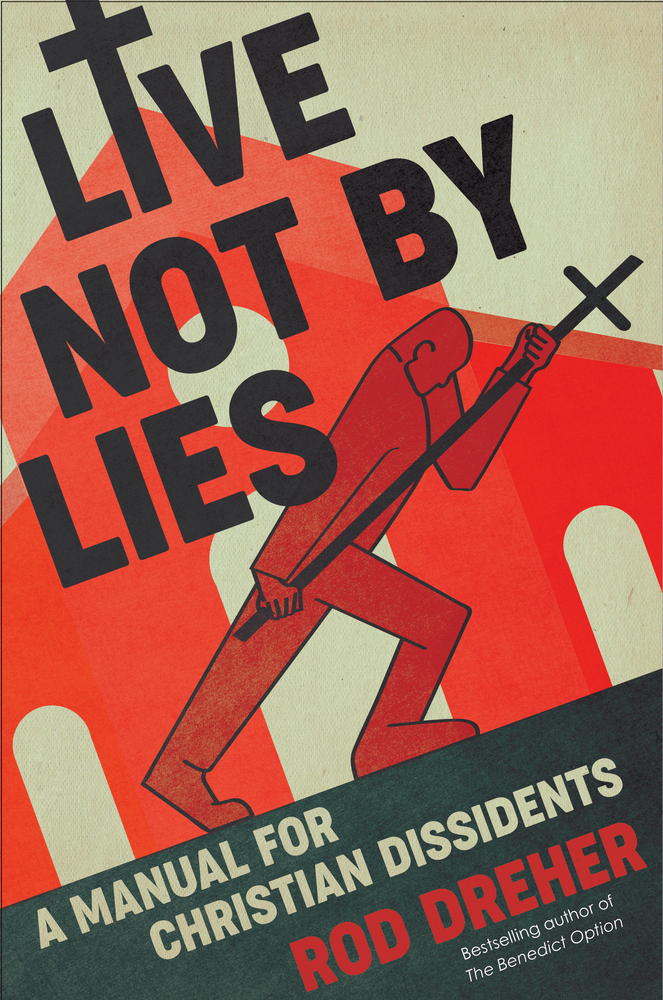Evans, GA. In The Benedict Option’s chapter on politics Rod Dreher says, “The question before us now is whether our current political situation is a betrayal of liberal democracy or, given its core principles of individualism and egalitarianism, liberal democracy’s inevitable fulfillment under secularism” (90). This has been a point of contention in the last few years, with some arguing for the latter (e.g., Patrick Deneen’s Why Liberalism Failed) and others maintaining the former (e.g., Robert Reilly’s America on Trial).

Dreher’s latest book, Live Not by Lies: A Manual for Christian Dissidents, does not attempt to explain why liberalism is in such a bad state. From start to finish, though, it is grounded in the premise that “classical liberalism is dying throughout the Western world” (29). Although Dreher never cites Deneen, his influence is apparent to anyone who has read Why Liberalism Failed.
In part 1, Dreher argues that “soft totalitarianism” is rising up in liberalism’s place. This is not to be confused with “simple authoritarianism. Authoritarianism is what you have when the state monopolizes political control” (7). Soft totalitarianism involves authoritarianism, but in some respects it goes even further, aspiring to “nothing less than defining and controlling reality” by means of “an ideology [that] seeks to displace all prior traditions and institutions, with the goal of bringing all aspects of society under control of that ideology” (7–8).
What makes this totalitarianism soft is that “it’s not establishing itself through ‘hard’ means like armed revolution, or enforcing itself with gulags. Rather, it exercises control, at least initially, in soft forms. This totalitarianism is therapeutic. It masks its hatred of dissenters from its utopian ideology in the guise of helping and healing” (7).
According to Dreher, the ideology we face “encourages people to identify with groups—ethnic, sexual, and otherwise—and to think of Good and Evil as a matter of power dynamics among the groups. A utopian vision drives these progressives, one that compels them to seek to rewrite history and reinvent language to reflect their ideals of social justice” (xi), and to eliminate such things as “whiteness, patriarchy, marriage, the gender binary, and so on” (43).
Many of these “progressive beliefs . . . are incompatible with logic—and certainly with Christianity” (8). Adherents accordingly “[regard] Christians as the most significant remaining obstacles” (68) to their success. Therefore, soft totalitarianism “[requires] the eradication of Christianity” (xiii).
Soft totalitarianism wields its power through various means. Dreher identifies the chief enforcers of this ideology as large corporations who have “[embraced] . . . aggressive social progressivism” (74), rather than the government (at least for now). One of their “soft” means of enforcement is simply refusing to do business in localities that aren’t sufficiently “woke.” As Dreher relates, a prominent case of such corporate coercion—one that yielded results—occurred in 2015, when “a powerful coalition of corporate leaders, including the heads of Apple, Salesforce, Eli Lilly, and others, threatened economic retaliation against the state [of Indiana] if it did not reverse course” (73) on a religious freedom bill passed earlier that year.
Another method of enforcement is the harvesting of personal data from willing consumers of smart phones, smart speakers, computers, credit cards, and the like (11), which corporations can then use to “punish individuals affiliated with political, religious, or cultural groups those firms deem to be antisocial” (80). At present, such punishment often takes the relatively mild form of “social media companies deplatforming users for violating terms of service” (79–80). However, more serious cases of consumers being punished for holding unacceptable views have already occurred, as “companies like PayPal have used the guidance of the far-left Southern Poverty Law Center to make it impossible for certain right-of-center individuals and organizations . . .to use its services” (80), something Amazon Smile does as well. Moreover, “Some major banks now have policies that deny service to firearms manufacturers and sellers” (89).
(Notably, Dreher does not recommend Christians divest themselves of their invasive technology, although his argument suggests such action would be advisable. This is probably because doing so would at a stroke destroy the careers and daily lives of millions. Also, as he himself remarks, “unless you are a hermit living off the grid, you are . . . thoroughly bounded and penetrated by the surveillance capitalist system” [77]. Even so, it would have made sense to discuss how people can cut down on invasive tech at least to some degree. For example, that products such as smart speakers are utterly superfluous is something everyone should be able to agree on, but it would also pay to remember that even ubiquitous devices like smart phones only became mainstream just over ten years ago. To claim we cannot live without them says more about us than it does about reality.)
In the face of these ominous developments, Dreher says, Christians “cannot hope to resist . . . if we do not have our spiritual lives in order” (xiv). A determination to “live not by lies,” a phrase taken from Aleksandr Solzhenitsyn’s essay of the same title, must be at the heart of this resistance. To live not by lies simply means refusing to acquiesce in thought, word, or act to the various falsehoods and denials of reality that constitute the ideology described above. In other words, “You may not have the strength to stand up in public and say what you really believe, but you can at least refuse to affirm what you do not believe. You may not be able to overthrow totalitarianism, but you can find within yourself and your community the means to live in the dignity of truth” (xiv, emphasis original).
Having explained the nature of the threat, in part 2 Dreher draws on the reflections of those who survived 20th-century Soviet communism as a source of wisdom and inspiration for us who are in a similar situation. From their experiences he gleans various principles for how Christians can strengthen themselves to live not by lies, such as “accepting a life outside the mainstream” (100) and “[living] with reduced expectations of worldly success” (103); preserving our “shared sacred and secular history” not only in word but through lived communal practices (127); cultivating family life in a “thoughtful, disciplined way” designed to be “intentionally countercultural” (149); nurturing in-person relationships to build up group solidarity (181); and re-learning “the value in suffering” (205) and bearing it “for the sake of God’s kingdom” (206).
Many of these practices should sound familiar, given that they are reminiscent of The Benedict Option. But Live Not by Lies is not simply a rehash. Indeed, Dreher’s belief that liberalism is dying—more prominent here than in his previous book—helps to explain some of the ways his thought appears to have shifted since The Benedict Option was published.
For example, Dreher barely even mentions religious liberty in Live Not by Lies, whereas in The Benedict Option he contends that “religious liberty is critically important” (84). While he does not expressly recant this view in Live Not by Lies, its general absence as a topic is conspicuous. It is easy to get the impression that he has come to believe there is no point in harping on such a liberal ideal as religious liberty when more and more of those who are in power are “militantly illiberal” (93) and thus “shove aside liberal principles like fair play, race neutrality, free speech, and free association as obstacles to equality” (34). As such, “they will not even understand why they should tolerate dissent based in religious belief” (xiii).
Relatedly, Dreher’s declaration that “wherever we hide, they will track us, find us, and punish us” (68) can be understood as an acknowledgment of one of the most frequent criticisms of the Benedict Option, namely that those who are hostile to traditional Christianity have no intention of allowing us to practice our “countercultural way of living” (Benedict Option, 2). If Christians cannot count on their religious liberty being protected, and if they have “virtually nowhere left to hide” (Live Not by Lies, xiii), then they must do as the Eastern European churches (and, for that matter, the early Christians) did and “build the underground church” (6).
Another possible development that seems to stem from Dreher’s greater emphasis on the death of liberalism concerns his treatment of reason. While he observes in The Benedict Option that “logical reason is doubted and even dismissed” (119) in our time, his skepticism toward the effectiveness of reason is even stronger in Live Not by Lies, where he suggests that attempting to convince our illiberal opponents through “secular liberal discourse, with its respect for discursive reasoning” (62) is a waste of time: “Some conservatives think that SJWs [social justice warriors] should be countered with superior arguments and if conservatives stick with liberal proceduralism they will prevail. This is a fundamental error that blinds conservatives to the radical nature of the threat” (63). The implication is that just as our opponents care nothing for liberal ideals, they have equally little regard for reason.
If we cannot reason with our opponents, it seems to follow there is little we can hope to accomplish in the realm of conventional electoral politics. This might be why in Live Not by Lies Dreher continues his support for what he calls the “parallel polis”—understood as “an alternative set of social structures within which social and intellectual life could be lived outside of official approval” (121)—but without the affirmation of “traditional politics” that was present in The Benedict Option (78, 82–83).
One thinks of Solzhenitsyn’s 1970 Nobel Lecture, where he invoked Dostoevsky’s belief that beauty will save the world and suggested,
Perhaps that ancient Trinity of Truth, Goodness and Beauty is not simply an empty, faded formula as we thought in the days of our self-confident, materialistic youth? If the tops of these three trees converge, as the scholars maintained, but the too blatant, too direct stems of Truth and Goodness are crushed, cut down, not allowed through – then perhaps the fantastic, unpredictable, unexpected stems of Beauty will push through and soar TO THAT VERY SAME PLACE, and in so doing will fulfil the work of all three?
In this vein, Dreher refreshingly observed in The Benedict Option that “the first Christians gained converts not because their arguments were better than those of the pagans but because people saw in them and their communities something good and beautiful” (118). Unfortunately, the role of beauty in our contemporary witness is not emphasized in Live Not by Lies.
In pointing out these differences between The Benedict Option and Live Not by Lies it is possible that I have misrepresented the development of Dreher’s thinking—perhaps he simply did not feel the need to repeat himself on matters already addressed in The Benedict Option. Nevertheless, the lack of even a basic reiteration of his previously expressed views leads me to believe his vision has shifted somewhat.
If I have read him correctly, Dreher’s outlook in Live Not by Lies is even grimmer than it was in The Benedict Option. This can be seen from the points discussed above, but it is especially apparent in his prediction that it will be necessary for the laity to “carry out catechetical, ministerial, and organizational roles normally performed by institutional church leaders who may be unable to do so under the law, or are too compromised in other ways to serve their proper function” (181–82).
Yet notwithstanding Dreher’s dismal assessment of our situation, he ultimately affirms hope for the future, just as he did in The Benedict Option: “Our cause appears lost . . . but we are still here! Now our mission is to build the underground resistance to the occupation to keep alive the memory of who we were and who we are, and to stoke the fires of desire for the true God. Where there is memory and desire, there is hope” (Live Not by Lies, 214). We may not be able to get through to others by “winning an argument” (120), but “as Orwell knew, simply by staying sane when everyone else is mad, we may hope to convey the human heritage” (127).
In closing, when The Benedict Option was published, multiple commentators—and some people quoted in the book itself—observed that the vast majority of its practices simply amounted to the church being what it always has (or should have) been (142). That claim is more difficult to make about Live Not by Lies, as some of its recommendations—e.g., Christians moving underground and preparing the laity to take on the bulk of church leadership—are clearly made with extraordinary circumstances in view. Indeed, some will be inclined to reject Dreher’s ideas as overly extreme or apocalyptic.
Tempting as this reaction may be, however, I encourage readers to give Dreher a fair hearing and consider the evidence he offers in support of his arguments. The phenomena he cites are real and disquieting, and he should not be dismissed out-of-hand simply because he forecasts a world far darker than many of us believe could possibly emerge. Whether events prove Dreher right or wrong about the future, he deserves credit for illuminating the simple truth that the scenario he describes has happened before and can happen again, even where it once seemed unimaginable.







1 comment
Anthony Oughton
Thanks for your review – I have not read Dreher but he seems to be putting forward one view of the Christian future with some clarity. On the topic of whether the early Christians were more likely to resort to well lived lives than well made arguments, why not think of both/and which seems more Biblical. An apologist like Francis Schaeffer was always concerned with beauty and goodness, but was also passionate about truth.
Comments are closed.